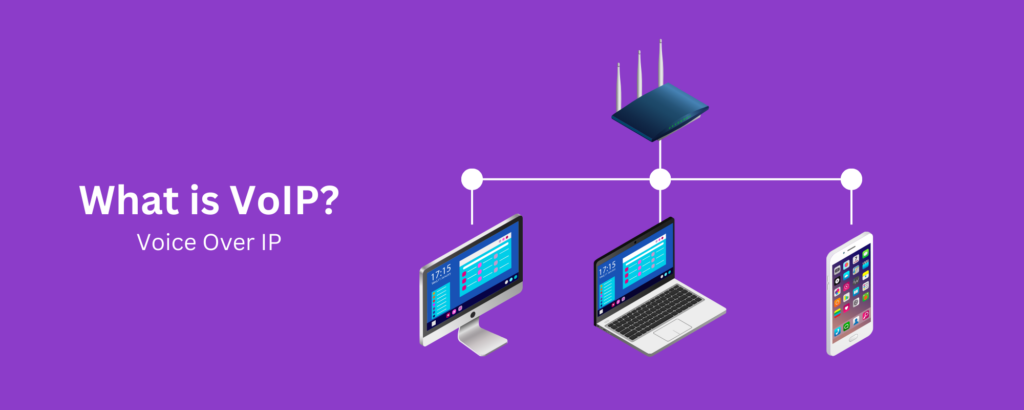What is VoIP?
Quick Menu

Revolutionising Communication: Understanding VoIP and Its Transformative Impact
In the ever-evolving landscape of communication technologies, Voice over Internet Protocol (VoIP) stands out as a revolutionary force, reshaping the way businesses and individuals connect. This blog post aims to demystify VoIP, explore its key features, delve into compelling statistics, and highlight the myriad benefits that make it a game-changer in the world of telecommunications.
What is VoIP?
Voice over Internet Protocol, or VoIP, is a technology that allows voice communication and multimedia sessions to be transmitted over the internet rather than traditional telephone lines. In simpler terms, VoIP converts voice signals into digital data packets, which are then transmitted over the internet to reach the recipient. This digital transformation has paved the way for a host of features and advantages that traditional phone systems struggle to match.
Key Features of VoIP:
1. Cost-Effective Calling:
VoIP often comes at a fraction of the cost of traditional phone systems, especially for long-distance and international calls. The utilization of the internet for voice transmission eliminates the need for expensive traditional phone lines.
2. Flexibility and Mobility:
VoIP liberates communication from physical constraints. Users can make and receive calls from anywhere with an internet connection, fostering flexibility and mobility. This is particularly valuable for businesses with remote or global teams.
3. Rich Features and Integrations:
VoIP systems offer a rich array of features beyond voice calls. These include video conferencing, instant messaging, file sharing, and integration with other business applications. Such versatility enhances collaboration and productivity.
4. Scalability:
As businesses grow, so do their communication needs. VoIP systems are highly scalable, allowing organisations to easily add or remove users, lines, or features based on evolving requirements.
5. Enhanced Call Quality:
Advancements in VoIP technology have led to high-definition (HD) voice quality, rivaling or surpassing that of traditional phone systems. Modern VoIP systems prioritize call quality, ensuring clear and reliable communication.
VoIP Statistics:
1. Global VoIP Market Growth:
– According to a report by Statista, the global VoIP market is projected to reach approximately 204 billion U.S. dollars by 2020, reflecting the widespread adoption of this technology.
2. Business VoIP Adoption:
– The State of VoIP report by GetVoIP reveals that as of 2021, over 70% of businesses in the United States have adopted VoIP in some capacity, emphasizing its prevalence in the corporate world.
3. Cost Savings for Businesses:
– Small businesses can achieve significant cost savings by switching to VoIP. A study by PCMag indicates that businesses can reduce their phone expenses by up to 75% by embracing VoIP solutions.
4. Global VoIP Subscribers:
– According to the International Telecommunication Union (ITU), there were over 1 billion fixed-line VoIP subscribers globally by the end of 2020, highlighting the widespread acceptance of this technology.
Why Make the Switch to VoIP?
1. Cost Efficiency:
VoIP is a cost-effective alternative to traditional phone systems. With lower calling rates, reduced hardware costs, and the ability to bundle services, businesses can achieve substantial savings.
2. Enhanced Collaboration:
The collaborative features of VoIP, including video conferencing and instant messaging, foster teamwork and communication among team members, regardless of their physical locations.
3. Global Connectivity:
VoIP transcends geographical boundaries. Businesses with a global footprint can leverage VoIP to maintain seamless communication, breaking down barriers and enabling collaboration across borders.
4. Scalability and Adaptability:
Growing businesses need a communication solution that grows with them. VoIP’s scalability and adaptability make it an ideal choice for businesses of all sizes, from startups to large enterprises.
5. Rich Feature Set:
VoIP offers a diverse range of features beyond traditional voice calls. Features like call forwarding, voicemail-to-email, and integration with business applications contribute to a more efficient and feature-rich communication environment.
6. Remote Work Facilitation:
The rise of remote work has made VoIP indispensable. It enables employees to stay connected from anywhere, ensuring that businesses can maintain productivity and communication continuity, even in distributed work environments.
In the era of digital transformation, VoIP emerges as a catalyst for change in the realm of communication. Its cost efficiency, rich feature set, and adaptability make it an appealing choice for businesses seeking to enhance collaboration, reduce costs, and embrace the future of telecommunications. As the statistics suggest, the global embrace of VoIP is not just a trend but a testament to its transformative impact on the way we connect, communicate, and collaborate. The time to make the switch to VoIP is now, as businesses strive to stay ahead in an increasingly interconnected and dynamic world.
